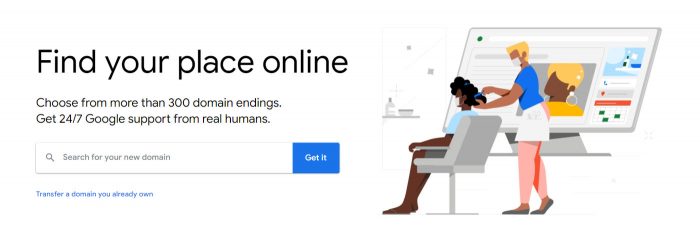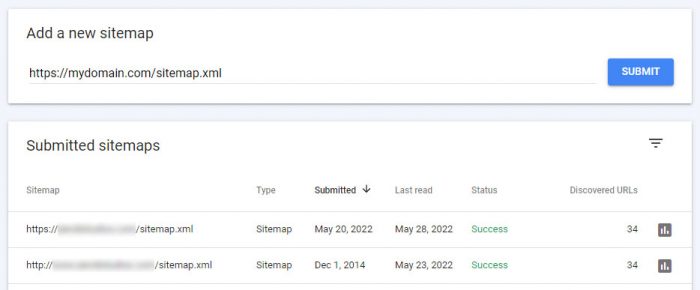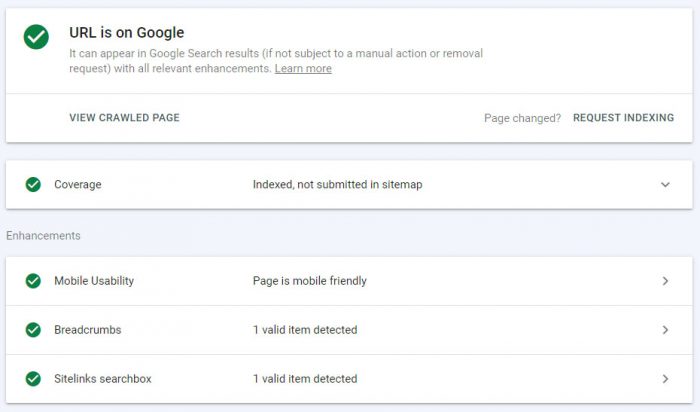13.4 min read -
15 Steps to Technical SEO success.
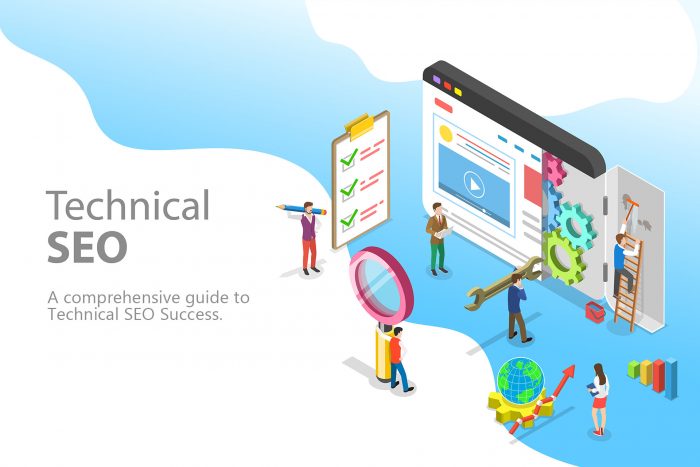
If you are looking to jump into the world of website creation and want to avoid critical SEO mistakes, then this is the guide for you. We will briefly take you through the process of technically building a website. We will fully explore how to form a technical SEO strategy that increases your website’s chance to rank well in SERPs and grow your SEO skillset. Whether you are sitting in the beginner’s position and choosing a perfect domain name or looking to optimize your site’s functionality, this is your guide to website creation basics and technical search engine optimization. These practices promote web domains that grow online enterprises. A great website educates and guides your audience. Our goal is to improve the internet both collectively as well as collaboratively. We will help you set your website up for success.
Before you start SEO
1. Search and purchase your preferred domain: (www or naked)
Your brand, logo, and domain name are your first impression. For this reason, there are several aspects to keep in mind when choosing your domain. You will want to ensure that it’s easy for searchers to pronounce and spell. It is hard to devise a digital marketing strategy for a poorly thought-out domain name. Complicated domain names can frustrate your potential audience and confuse incoming seekers. Once you’ve made this decision, purchase your preferred domain.
Here are the top 7 things to consider when embarking upon this journey:
- Avoid hyphens. They are often confusing when used verbally and become frequently overlooked when typing.
- Check for trademarks. Mistakenly using trademarked sites and phrasing can cripple a company.
- Keep your domain name short. Long domains become easily forgotten and misspelled. Under 20 letters is the gold standard.
- Make it unique. It is easier said than done, but this is critical. Catchy names spur recollection.
- Keep it brandable. You aren’t just selling a product; you are building a brand.
- Do your research. Understand the keywords for your area of commerce to ensure that you will brand yourself at the top of Google’s query.
- Think long-term over short-term. Avoid being trendy. Can this domain name migrate if my audience broadens? If so, you are on the right track.
What is the key takeaway?
Choose wisely. Changing a domain name is costly. Mistakenly choosing a domain that is too similar to competitors can confuse your audience. It is imperative to purchase all of the options of domains similar to the one you have chosen and the mother domain to deter cybersquatting.
Google reads subdomains to be individual domains unrelated to each other. In contrast, Google interprets subfolders as a collection within a larger company with an expert level of experience and a vast content library. This action alone will boost your SEO and rankings.
2. Register your domain name
Feel free to browse Google to find the company that you like best. These are a few of our favorites:
3. Choose Your Hosting Provider
Choose a hosting provider for your website. They provide the storage space for your website and are frequently offered by the domain seller. Either a physical server or a cloud-based virtual machine (VM) will do.
4. Link your domain name to a static IP address
IP stands for internet protocol; this is a unique address formed of a specific string of numbers that identifies a device on the internet. Your IP address links to your domain name.
There are several hosting providers on the market; we suggest Google Cloud Platform, better known as GCP, for its flexibility. Although if you’re new to setting up hosting, we suggest you hire a professional. If you’re technical enough, there are dozens of great tutorials online that can help you set up your virtual machine(VM) and Domain Name System(DNS). In this phase, you will need to add a DNS record to associate your new domain name to your static IP. In GCP, IP addresses are dynamic by default, and you should reserve a static IP before you link your domain name to it.
5. Install WordPress onto your server
Since 43% of the web is built on WordPress, you can easily rely upon this website building giant to meet your needs. Website creation options are endless. Other options may appear faster and more effective. Although, they lack the extensive customization aspects that WordPress offers. Copying the WordPress installer to your server and building your website is pretty straightforward. GCP has some great one-click deploy options in their marketplace that can expedite this process.
We recommend partnering with a professional website creation company to facilitate optimal SEO compliance since technical SEO strategy is key to organic discovery.
15 Steps to Technical SEO
1. Establish Website Architecture
This critical step is often overlooked and can create SEO issues. This mistake can be very costly and frustrating. Setting a framework and defining your site structure will increase usability, create a better user experience between pages, ensure efficient crawl-ability, and improve your rank and authority.
2. Set up a sitemap
Now that you have built your website, this is where technical SEO begins.
A sitemap is a file on your website that many of your customers will never see. Sitemaps serve as a content guide. It is a diagrammatic visualization of website construction. It comprises a directory of URLs that pinpoint specific categories and resources within your website. These URLs are keyword-specific links that directly reference content within your website.
SEO tools like AIOSEO and Yoast can automatically generate your sitemaps based on your website layout. Sitemaps pinpoint your page SEO to help drive traffic.
Google must index your web presence, and indexing is crucial for online discovery. Your XML sitemap is the fastest way to streamline and expedite this process.
3. Submit sitemap to all major search engines
- Create your Google Search Console account and reference your XML sitemap.
- Create your Bing Webmaster Tools account and reference your XML sitemap.
- Create your Yandex Webmaster Tools account and reference your XML sitemap.
4. Subfolders and subdomains
What is the difference between a subfolder and a subdomain?
The primary difference between the two is that Google reads them very differently.
Subdomains look like this:
- services.mynewcompanydomain.com
- tutorials.mynewcompanydomain.com
- blog.mynewcompanydomain.com
Subfolders look like this:
- www.mynewcompanydomain.com/services
- www.mynewcompanydomain.com/tutorials
- www.mynewcompanydomain.com/blog
5. Use Friendly Permalinks
Permalinks are permanent URLs of information found on your website. Link building is acquiring hyperlinks from other websites to your own. These can come from several sources on your site, such as blogs, pages, posts, and other archives. Friendly permalinks with consistent URL structure help categorize information for both humans and search engines to share and understand. You have undoubtedly been using permalinks to share information with your friends. Google uses them to index your website and articles. Bloggers use permalinks to create links to other articles. Simply put, permalinks organize the internet and help us all share information.
Understanding the difference between ugly and friendly permalinks will help your domain become a trusted and cataloged resource for the internet instead of an un-searchable and untrusted business.
Plain or “ugly” permalinks look like this.
- http://mycompanynamedomain.com/?p=N
Ugly permalinks are not user-friendly, nor are they helpful for SEO. Since permalinks drive traffic to your site, You should never change them on a live website. Changing a permalink (which we do not recommend) on a live webpage requires a 301 redirect. Otherwise, it will cause broken links to anyone linking their information to yours. Search engines take note of broken links. If there are multiple broken links on your website, your website is at risk of becoming devalued or penalized by Google. For this reason, we recommend using friendly permalinks.
Friendly permalinks look like this.
- http://mycompanynamedomain.com/post-name/
Friendly permalinks are like a roadmap through your website. Search engines will organically choose efficiently organized and labeled pages.
It is essential to optimize your keywords and update them regularly. Ultimately, the more you contribute to the internet, the greater the internet becomes. Google is the gatekeeper. Friendly permalinks keep the internet cohesive. In the final analysis, optimized SEO makes you more money.
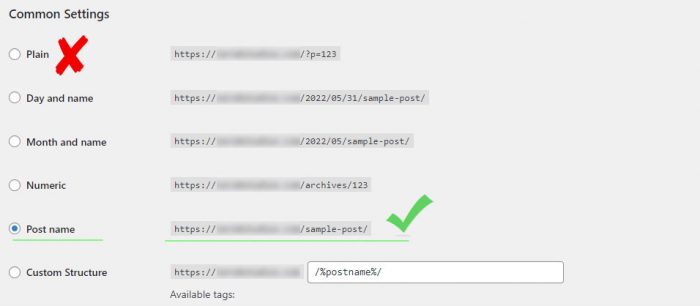
6. Understanding canonical URLs and canonical Tags
What is a canonical URL or a canonical link? The specific URL of the page relays to search engines that a particular URL is the master copy. Canonical URLs and tags direct traffic to the important pages on your site. For example, If you sell various types of clothing and specialize in making jeans, a canonical tag will express to search engines that a specific item, like jeans, is authenticated. The idea is that there can be hundreds of URLs associated with clothing on a website. Setting a canonical URL will clearly define that this specific canonical URL or tag for jeans is the master copy of your page.
What is a canonical tag? A canonical tag is located in the <head></head> section of a web page’s HTML source code. A canonical tag looks like this:
<link rel=”canonical” href=”https://www.yourbusiness.com/page/” />
These tags reference back to your own page’s URL, or they can reference another page’s URL to consolidate signals.
7. Request Crawling for Faster Indexing
Website indexing is a complicated business. Requesting crawling will expedite the process of online discovery and promote your Google ranking factor. Crawling takes time. Google anticipates a few days to a few weeks for indexing.
If you are interested in monitoring the progress of your status, here are two tools they offer: Index Coverage Report and URL Inspection Tool.
Keep in mind that multiple recrawl requests will not expedite the indexing process.
Once the crawl is complete it should look something like this.
8. Check for Crawl Errors
What is a crawler?
Simply put, there are three main components of Google. The first is a crawler. The second is an index, and lastly, the algorithm. Google’s crawler, Googlebot, scans the internet endlessly. Googlebot will find your website. Once that happens, it will render your website and save the HTML version of your website into the index. Flawless websites are quickly indexed. It is imperative to keep website content fresh and updated. Make sure that you don’t have any duplicate content issues. Duplicate pages will lower your index and reduce your authority rank. The more you change and grow your content, the more often bots will crawl your site.
9. Check that Google Can Crawl Your Pages
It is essential to run regular assessments on your website to ensure health and accessibility. If the content on one of your pages becomes unreadable, that page will not be indexed. For example, search engines will use your robots.txt file to access your URLs. These crawlers will render your page unreadable if there is a crawl error. Google bots will assign a status code to determine page errors, i.e., 404, 403, 503, etc. Website crawl-ability is a critical component. Your crawl budget is optimized when your pages function seamlessly. In some cases, you can add a no-index tag to tell Google and other search engines not to index the page. Use no-index tags when you know a page is not changing and does not need to be crawled or indexed.
Remember that we all have different skillsets; you may need assistance for more intensive and technical SEO. Identifying what you can fix yourself and when to involve a developer or a search engine optimization specialist may become a challenge.
10. Review Crawled Results from Google
Google sends an advanced report to analyze the overall performance of your domain. It is a comparative analysis that breaks down the following crawl information about your site: total crawl requests, total download size, average response time, host status, crawl responses, file type, crawl purpose, & Googlebot type, to name a few. With this report, you can perform a site audit to ensure your website’s health and interactive function.
11. Use Structured Data (Schema Markup)
Search engines understand structured data better than standard text. Schema markup has become a hot topic of SEO. Schema markup is a structured data vocabulary that helps search engines better understand your content. It allows search engines to see the meaning behind your content, which gets interpolated as a rich result. Rich snippets are proven to improve click-through rates. Pages that display rich snippets drive more organic search results.
12. De-Index Duplicate Content
Crawlers are consistently indexing your content. Ultimately, the more you contribute to the internet, the greater the internet becomes. Google is the gatekeeper. Accurate indexing keeps the internet cohesive. In the final analysis, optimized SEO makes you more money.
13. Install an SSL certificate (HTTPS://):
Now that you have your domain and website set up and completed an initial technical SEO pass, one of the important steps in today’s SEO world is securing your site. You need to install a security certificate. Remember that SSL certificates must be linked to only one domain name and not an IP address; this is impossible. Consequently, installing your cert in later development stages is a suitable practice method before your site goes live and is connected to the domain. This can also pose some interesting problems that we will discuss as we get more into web design.
- What is SSL?
SSL stands for secure sockets layer. It is a security protocol that creates an encrypted link between a web server and a web browser.
- What is an SSL certificate?
An SSL certificate is a digital certificate that authenticates the identity of a website. SSL certificates ensure that online transactions are private and secure. They provide ownership of the website and prevent hackers from mimicking a website to obtain critical information. SSL certification maintenance ensures that a customer is safe to log in and share personal information such as login information or banking credentials. Google now considers having an SSL cert on your website one of the more critical aspects of your SERP. This is noted by the HTTPS prefix on your URL.
This is what your site will look like once the SSL certificate is installed and operational. Denoted by the lock to the left of the URL.
14. Security Checks and Plugin Updates:
Perform monthly security checks and plugin updates. Since SSL Certificates do expire, it is vital to watch for expirations. Google will flag your site as unsafe and categorize your web presence as potentially fraudulent without an SSL certificate. Consequently, users will avoid divulging proprietary information. Regular security checks using tools like Wordfence and plugin updates prevent unnecessary setbacks.
Here is an example of why security is so important. As you can see in this screenshot the number of attacks on a website per hour can be very high. That’s why it’s imperative that your block IP addresses that are attempting to break into your website. All of these humans or bots were blocked by a 503 response automatically. Proper setup of security tools is essential to your website SEO, you don’t want to block real people or search engine indexing bots.
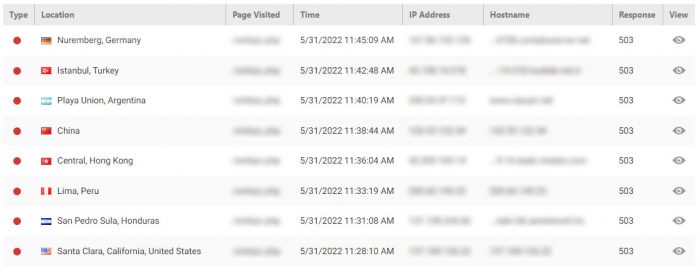
15. Conduct monthly SEO Audits:
Technical SEO audits are an essential task in today’s online enterprise. Auditing your SEO ensures that your keyword research is up to date. Your web presence is the gateway to your audience. Fresh keywords are crucial. The internet is a living and growing presence that will devour your domain if left unattended. Using modern SEO is the best way to keep your web domain safe, searchable, and relevant is critical.
We can help.
Are you ready to set your website up for success? We are here to help. The team at Zero8 has decades of experience and a portfolio of happy clients. SEO is an ever-changing challenge; we help our clients stay ahead of the curve and keep their sites functioning and ranking. We offer a variety of SEO Service Plans depending on your needs, so you don’t have to stress about your web presence falling out of compliance. Let’s start cleaning up your online presence and get your business growing. Contact us today.
Phone number: 844-338-4263


